|
TREATMENTS FOR CATARACT
How and when to treat cataract ?
Adapting your glasses is not a good solution. The most effective way in dealing with cataract is to remove the lens and replace it with a classic lens implant or an accommodative lens implant.
In earlier times surgeons waited for the total clouding of the lens . Nowadays having improved operating techniques and pre-operative examinations surgeons propose surgery when the cataract is impairing the patients daily tasks (reading, working, hobbies, driving,…)
Cataract can reduce your vision so much that it becomes illegal to drive.
What happens before the operation ?
Before the eye surgeon proposes the operation the patients will receive a thorough eye examination.
These examinations result in :
- The state of the patients eye (not only the lens but the whole of the eye), excluding other eye diseases
- An exact proposal regarding which implant (type and dioptric power) is best suited for the patients eyes.
Both eyes are operated on with a 2 week interval. Checkups are needed between and after the surgery.
CHOICE OF IMPLANT
1. Acrylic monofocal implant
A foldable lens is injected into the eye using a special injector through a 2.75mm opening.
The opening needs no stitches for it is so small and waterproof. The expected result is good vision without the need of glasses for far distance but a remaining need for reading glasses.
2. PRELEX
Patients over 45 years of age may have reading problems, a condition known as presbyopia.
This loss in lens elasticity is a normal age related change in the eye.
They need reading glasses and now this condition can be treated with prelex (presbyopic lens exchange) also called refractive lens exchange. Under local anesthetic we aspirate the clear intraocular lens and place a multifocal or accommodative artificial lens (IOL) in the capsular bag. The artificial lens is placed through a 2.2 mm. self-sealing incision. It is a painless procedure and after the surgery a patch will be placed over the eye and you can leave the center for your hotel. So after this intervention people can again see far and near. They actually have two focal points. The IOL becomes a permanent part of your eye. These procedures are performed in a private setting on an out patient basis.
The quality of the multifocal lenses has improved significantly to make prelex surgery highly successful.
2.1 Multifocal implant
In 2002 our surgeons started using these implants. The incoming light is divided into a focus for near and a focus for far distance.
After bilateral surgery with this type of implant 81% have no more need for glasses, the others need them for intermediate distance.
These implants can cause in a minority of patients temporary problems such as glare, some loss of contrast and halos around bright lights
2.2 Accommodative implant
This implant has a specific design allowing the optic of the lens to click forward when accommodating ( = contraction of the cilliary muscles with increase of vitreal pressure and constriction of the lens capsula causing the lens to click forward ) resulting in a good vision far and near. For the first month after surgery the eye should be trained, relearning to accommodate (as people do before they are 40 years old when fixating nearby). Some patients still need reading glasses for very small print and reading in dim light.
Cataract operation technology used by the eye surgeons ?
The name of the technique is faco-emulsification ( faco = lens , emulsification = breaking up using ultrasound waves) The lens is removed with state of the art Infinity technology by Alcon ( market introduced since januari 2005). Alternating ultrasound waves for pulverising the lens and zero frequency waves for diminishing warmth production in the eye makes this technology "a cold emulsification technique". This means it's a very safe procedure that allows for a fast vision recovery.
What happens during surgery ?
Cataract surgery is done under local anaesthesia. Patients remain awake but will not feel a thing. They will see some vague movements but no details during surgery. The surgeon will make 2 micro incisions and will perform the operation using a microscope.
The front membrane of the lens is opened to provide acces to the lens matter.

During the procedure the lens is broken up and removed using an ultrasound divice.
 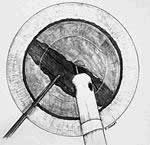 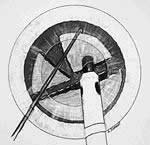 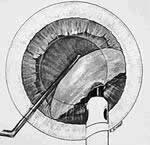
The new lens or IOL (intra ocular lensimplant) is introduced and centered in the original lensbag keeping the back membrane intact, assuring that the IOL stays in place.
This entire procedure is finished within 20 minutes.
The surgeon will place a plastic shield over the operated eye. This prevents the patient from rubbing the eye involuntary.
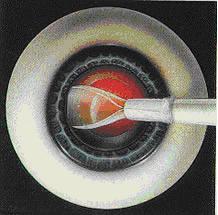 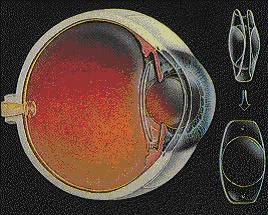
The patient leaves the hospital the same day after resting for a while.
What is the care afterwards ?
The eye shield should be put on each night, no more need for a bandage, during the first 2 weeks after surgery.
The first month after the surgery patients need to administer eye drops.
Some patients have a hard time using the drops, so a private nurse can come to the house.
The minimal postoperative checkup is the next day, eventually another check up can be done 4 to 6 weeks after the intervention but the local optician-optometrist can also prescribe reading glasses if necessary. Patients with monofocal implants will need reading glasses for all print, patients with accommodative or multifocal implants only need light reading glasses for very small print. The lensbag (capsule) that remains can cloud in the course of the next months or even years after surgery, to resolve this small inconvenience when symptoms occur (blurred vision) a brief painless laser treatment is performed during normal consultation with the eye doctor.
What are the results after surgery ?
Most patients experience an immediate improvement and more vision restoration requires a couple of weeks patience. We advise patients to take a few days off.
Some very important things to be aware of :
1. No rubbing the operated eye
2. No bending over and lifting heavy things during the first 2 weeks after each surgery
3. No swimming during the first 2 weeks after each surgery
FAQ
• Will I be able to feel the lens ?
The IOL becomes part of your eye, like the natural lens. You will not feel its presence.
• Will the vision result last forever ?
The correction is designed to be permanent, excluding any other eye disease.
• Are there any complications ?
As with any surgical procedure the possibility of complications is always present.
But please remember that most complications are minor and rare (less then 2% of the patients suffer from complications) and can be easily treated with additional eyedrops. These can delay your recovery. The doctor will examine you to determine if you are at higher risk during your initial consultation and discuss this with you.
• How long after surgery before I can see without glasses if I choose an accommodative implant?
Your vision will return gradually over a few hours and by the following day your vision will be significantly better.
The improvement continues over the next weeks.
• Will I have 10/10 vision at all distances if I choose an accommodative implant ?
While these types of IOL are designed to provide 10/10 vision for all distances, some people will not get this grade of success.
Remember, most people do not have 10/10 vision inat all distances, even with glasses, contact lenses,… yet function comfortably.
Most patients should not need glasses for 90-95% of their daily activities.
Most people need a simple pair of glasses for reading very small print or for reading in dim light.
• Is there anything I can do to improve my vision even more after having a classic implant?
Use good light for reading and other near tasks combined with correct near glasses
• Is there anything I can do to improve my vision even more after having an accommodative implant ?
Use good light for reading and other near tasks
Don’t use reading glasses for anything but the small print, your natural reading system (accommodation) needs to be used, using glasses too soon makes the system “lazy”
|







